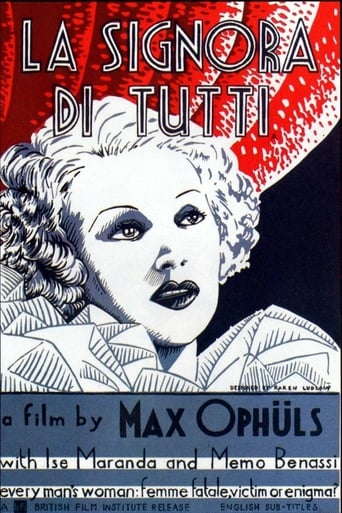writers_reign
This is a stunning early sound film from Max Ophuls which deservedly won a 'technical' award at Venice. It's difficult to imagine that old Awesome did not include this in the dozens of films he watched before making Kane because Ophuls uses, some seven years earlier, many of the techniques, not least overlapping Sound, that crystallised in Kane. The plot verges on the melodramatic but the Style is something else; flashbacks within flashbacks, lush tracking shots, montages, dissolves, everything in fact from what those academics love to call the 'grammar' of film making is present and correct. A film in 1934 that begins with a wipe of the label on a 78 rpm record and ends on a static shot of the face of the heroine on a poster has to be out of the right bottle and this is vintage. Dix sur dix going away.
genet-1
This overblown romance prefigures such Hollywood melodramas as WRITTEN ON THE WIND, but, like Douglas Sirk's tale of life among the oil aristocracy, is redeemed by technique, in this case Ophuls' spirited use of moving camera. Everyone in the cast chews the curtains with appetite, particularly Isa Miranda as Gaby, the neurasthenic movie star who, following one of her many collapses in the course of the film, re-experiences the key event of her life, an unhappy love affair with married magnate Leonardo which led to the accidental death of his invalid wife, and Gaby's subsequent guilty breakdown. Nobody tracked or craned the camera with more flair than Ophuls, and he uses both techniques expertly in this film, often, it seems, for no motive more weighty than simple glee at his expertise. An insignificant conversation between Gaby in a rowboat on a sun-lit lake and Leonardo driving his convertible along the bank is elaborately staged as two long tracking shots, with Ophuls intercutting between them. Similar flair marks the death of wheelchair-bound Alma, her shadow racing ahead of her along the floor as she pushes her chair to the head of the stairs, then teeters and falls. Other sequences are too spasmodic, in particular those at the film studio, with Gaby's cliché cigar-chewing agent negotiating a new contract with the equally stock studio head, and,later, Leonardo facing a hostile board that attacks him for neglect of the company. Miranda is at her febrile worst in this film, and it demands considerable suspension of disbelief to accept as her married lover the overweight and stolid Memo Benassi, whose primary acting technique is to stare into the middle distance and fire up another cigarette. But any enthusiast for Ophuls' fluid camera will find the film a delight.
dbdumonteil
In Max Ophuls'work,if you were born a woman,you were born to suffer.If there are exceptions,they are very rare : from "Liebelei" where a woman's true love was only a "liebelei" to "Sans Lendemain" where Edwige Feuillère was prisoner of a racy past to "letter from an unknown woman " where Joan Fontaine 's love was in vain to the masterpieces of the fifties "Madame de" and "Lola Montès" .Even in the much debated "De Mayerling à Sarajevo" the historic Sophie Chotek (Feuillère again) character was also a humiliated woman."La signora di Tutti" actually predates "Lola Montès" by twenty years:it's a long flashback after the heroine's suicide.The first sequences are nervy ,tense,the dialog begins with numbers and you soon realize they're talking about money.Isa MIranda portrays with talent a woman whose biggest fault is to be all along the film the right woman in the wrong place.Every man she loves leads her to a dead end : the music teacher,the businessman,his son.Great scenes:the opera ,an imaginary way for the lovers to escape ;Ophuls's great fascination for the trains (see also "letter to an unknown woman" "De Mayerling à Sarajevo" and even the "la maison Tellier" segment in "LE Plaisir" in a comic way);Alma's tragic death ,the shadow of the wheelchair on the wall,the radio which Gabriella smashes ; and above all,the final pictures when the press slowly stops .A strong influence on Mankiewicz ("Barefoot Comtessa" ),Louis Malle (" Vie privée")and on the melodrama genre (Sirk)The flashback was not so innovative after all(the year before,Stahl did the same in "only yesterday" ) but the directing which sometimes has thriller accents (the scene when the heroine hears a radio nobody can't hear would not be out of place in a psychological suspense;ditto for the wheelchair scene in the night which is really awesome.
Mario Naito
Signora di tutti is truly one of the most underrated films of movie history. When I saw it ten years ago I was marveled about its modernity although belonging to 1934. I´m sure Welles undoubtely watched it before filming Citizen Kane, because Max Ophuls´s narration and editing techniques in that picture somehow anticipated Orson´s landmark screen jewel. This movie deserves a standout place in the development of film language.


 AD
AD



